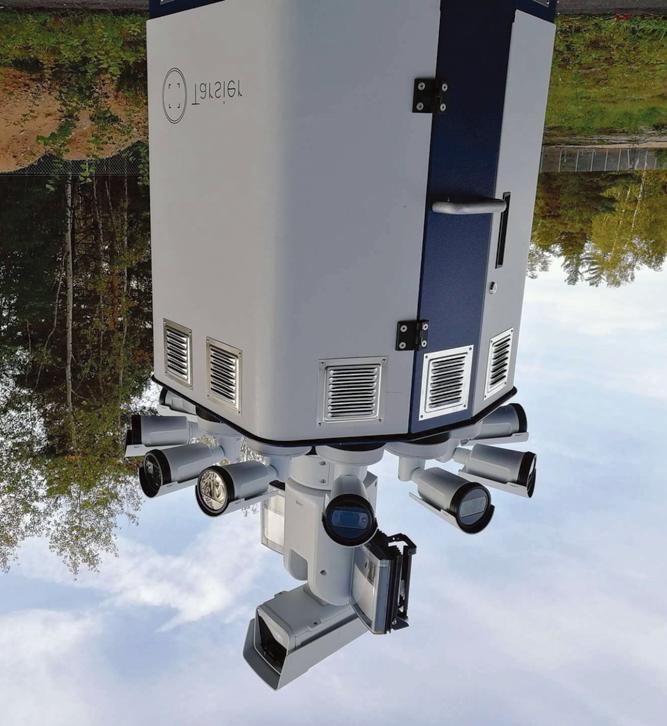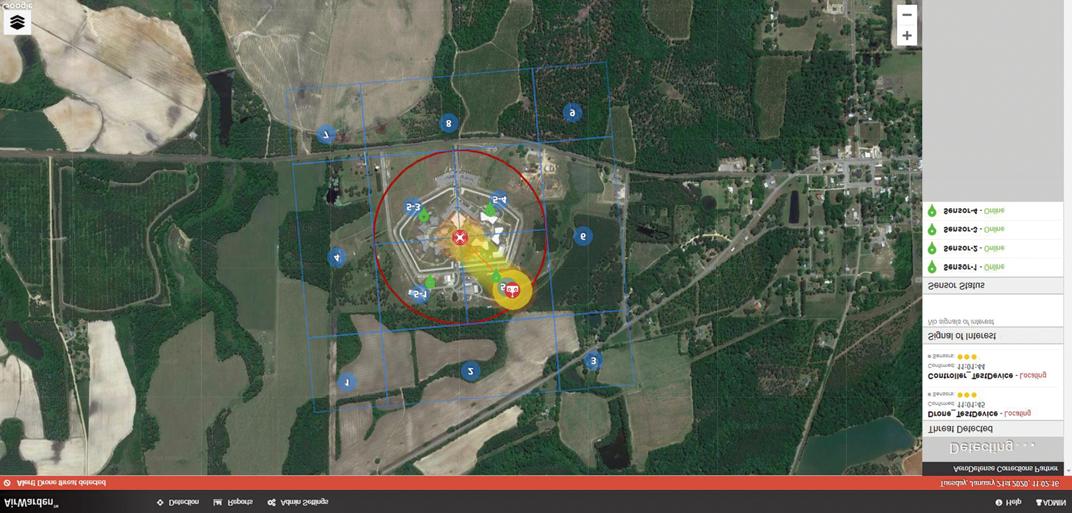
15 minute read
Coronavirus: Managing Safe Buildings
Keeping Buildings Safe & Healthy With a Managed Cleaning Program
DISINFECTANT
Advertisement
With the emergence of Novel Coronavirus outbreak, it is important to revisit the guidance from the CDC on preventing the spread of infection.
Since most infectious pathogens are primarily spread through person-to-person contact, hand hygiene is a primary part of preventing transmission. Facilities should ensure that adequate hand hygiene solutions are available and proper hand hygiene techniques are observed. Although microbiologically contaminated surfaces can serve as reservoirs of potential pathogens, generally these surfaces are not directly associated with transmission of infections. The transferal of microorganisms from environmental surfaces to people is largely via hand contact with the surface. Although hand hygiene is important to minimize the impact of this transfer, cleaning and disinfecting environmen


tal surfaces as appropriate is fundamental in reducing their potential contribution to the spread of viruses.
Selecting the Correct Disinfectant for the Job
A one-step disinfectant has been verified by the EPA to be effective against named organisms in the presence of 5% blood serum solution. Remember to consult the product label to identify the correct product for the target bacteria or virus. Because the Novel Coronavirus is so new, the EPA has activated its Emerging Viral Pathogens Guidance for Antimicrobial Pesticides.
One-step Disinfectant Concentrate
BNC-15 (EPA Reg # 6836-348- 5741) has demonstrated effectiveness against viruses similar to 2019 Novel Coronavirus (2019- nCoV) on hard, non-porous surfaces. Therefore, BNC-15 can be used against 2019 Novel Coronavirus (2019-nCoV) when used in accordance with the directions for use against Human Coronavirus on hard, non-porous surfaces. Refer to the CDC website https://www.cdc.gov/coronavirus/2019-ncov/index.html for additional information.
Ready to Use Disinfectant
Cide Quat (EPA Reg # 1839-83- 5741) has demonstrated effectiveness against viruses similar to 2019 novel coronavirus-Wuhan (also 2019-nCoV) on hard non-porous surfaces. Therefore, this product can be used against 2019 novel coronavirus-Wuhan (also 2019- nCoV) when used in accordance with the directions for use against Human Rotavirus, Rhinovirus Type 39, Hepatitis A virus, Poliovirus Type 1, and Canine Parvovirus on hard, non-porous surfaces. Refer to the CDC website (https://www.cdc.govcoronavirus/2019-ncov/ index.html ) for additional information.
A managed cleaning program is the most effective weapon against the spread of viruses. Facility managers need to ensure that HTPs (High Touch Points) are being properly cleaned and disinfected.
Hand washing and sanitizing solutions are your first line of defense against the spread of pathogens. Effective cleaners and disinfectants break the cycle of infection on high-touch surfaces. Training and education tools ensure safety, professionalism, and compliance. ✪
Information supplied by David N. Reed, Vice President, Spartan Chemical Company, Inc. For more information go to spartanchemical.com.
SEE CORRECTIONSFORUM.NET FOR LINKS TO RESOURCES TO FIGHT COVID-19.



Detecting Drones Drone technology is advancing rapidly with faster, smaller drones with longer ranges and payload capabilities. Counteracting them can be complex. Here are some issues to consider.
There has never been a shortage of schemes to try to get contraband into prisons, but the sudden proliferation of drones probably caught everyone at least a little off guard. It’s not just a matter of contraband, either. In January 2019, a drone tried to capture footage of Bill Cosby as he was escorted around the prison yard at the State Correctional Institute Phoenix in Collegeville, Pa. (Officials and Cosby’s reps believe the device was a media drone.) In July 2018,
Tarsier’s AirScout system can be used on a standalone basis with only Tarsier's artificial intelligence-powered cameras, or it can be integrated with other drone detection sensors such as radar, radio frequency, and acoustic.



Redoine Faid, a career-criminal, escaped from Reau Prison near Paris, France, with the help of a heavily armed team. In the months before the escape, drones were spotted flying above the prison and are now believed to be linked to the breakout. He was apprehended a few months later.
Drones bring a unique set of challenges. Obviously they can fly, but they are also inexpensive, easy to use, and there are a lot of them. As of 2018, Federal Aviation Administration (FAA) figures showed there were more than a million drones registered in the U.S. It is projected that by

2021, there will be more than 3.5 million. Gary Andrews, general manager and CEO of DeTect, a Panama City, Florida-based company that specializes in advanced radar and other sensor technologies, notes that the problem is “quite prevalent and increasing.” He furthers, “New reports of drones used to smuggle contraband into jails and prisons appears almost daily.”
Lexi Rinaudo, marketing manager at AeroDefense, a New Jersey-based provider of solutions to detect drones at correctional facilities, stadiums, and other “high value targets” says: “Since around 2017, contraband delivery attempts have become increasingly more prevalent. In some facilities, drugs are a significant problem, but the problem varies by facility and usually correlates with gang activity in the area. Many facilities act as known distribution hubs. Due to the increasing threat, drone detection technology has been deployed at facilities throughout the US.”
The array of contraband is vast. In 2017, an inmate in a South Carolina facility escaped using a pair of wire cutters delivered by a drone, so while contraband is a safety concern for staff within the facility, it can also clearly be a matter of public safety.
Kyle Meloney, CEO of Tarsier, a San Francisco-based leader of camera-based detection and tracking system for rogue drones, explains how the threat continues to increase in sophistication. “At first it was simple contraband drops, using off-theshelf and widely-used DJI drones flown manually via the radio frequency communication between the drone and its pilot. The initial threat was followed by strategic contraband drops— including night drops and coordination with inmates inside. Currently, we're observing a move away from widely-available consumer drones towards lesser known manufacturers, custom-built drones, and self-piloted drones.”
Methods of Dealing with Drones
Technology makes it possible to fly a drone into a facility, so technology can be used to keep one out. One way DeTect supports the corrections industry is with its DroneWatcher™ (DW) detection and defense system, which Andrews describes as “an advanced, multi-level sensor system that detects, tracks and alerts of drones and small UAVs.” He notes that DW includes advanced radio frequency (RF) sensors and radar that was developed specifically for detection and tracking small radar cross section (RCS) targets in high signal clutter environments. Furthermore, the DW radar also includes specialized algorithms in order to reduce false positive alerts from birds, a common flaw in drone-detection radars. The system also includes a powerful data server and command and control (C2) system that allows integration of other sensors including 4K cameras, advanced electro-optics, and drone interdiction jammers (in states where they are legal). DroneWatcher C2 also supports customized user displays and alerting by video, audio, and text messaging.
AeroDefense’s AirWarden™ also uses radio frequency-based drone detection technology to prevent and respond to dronebased contraband introduction attempts. Says Rinaudo, AirWarden detects, locates, and tracks both known and unknown drones and their pilots simultaneously. The system offers audio/visual, text, and email alerts that are configurable based on role and type. For example, when a detection has started and stopped, the warden may want to
AeroDefense’s AirWarden detects, locates, and tracks both known and unknown drones and their pilots simultaneously. The system offers audio/visual, text, and email alerts.

be alerted only by email and/or text while the response team may prefer text only notifications as the device’s location changes. Alerts can also be sent to local law enforcement for a coordinated response. Users with access to reporting functionality can select and download information about a specific detection event, multiple detection events, and a summary of all devices detected. Users can also easily create an incident report of multiple detections.
AirWarden has been used with success at several correctional facilities across the US. For example, says Rinaudo, “Georgia’s proactive response plans along with the use of AirWarden as an early warning system has resulted in several key incident detections, the interception of over $500,000 in contraband, and suspect arrests. Most importantly, drone delivery attempts have essentially been eliminated.”
Tarsier’s AirScout provides an automated, reliable way to detect and track unwanted drones and protect officers, inmates, and the facility’s operations from droneborne contraband, the company notes. It can be used on a standalone basis with only Tarsier's artificial intelligence-powered cameras, or it can be integrated with other drone detection sensors such as radar, radio frequency, and acoustic.
Latest Developments
Recent developments, says Andrews, include bird target rejection algorithms and classification systems and non-RF interdiction systems. “DeTect’s bird classification technology is based on its avian radar products that have been used worldwide since 2003 to classify bird targets in real-time. Non-RF interdiction products include ‘drone catcher’ drones and other technologies to bring down non-authorized drones without damaging surrounding systems (e.g. electronics).”
Rinaudo notes that the AirWarden system uses spectrumsensing technology to provide the data staff needs to respond to drone threats. Sensors that both detect and locate are distributed around the facility perimeter. Multiple sensors utilize a method called trilateration to determine the signal source and provide an estimated location. When a detection occurs, the signal is analyzed and run through several filters to ensure that it is in fact a drone or controller signal and to calculate its location.
AirWarden provides an audio/visual command console alert and can be configured to send emails and/or text messages with pertinent information. The system now also offers a mobile drone detection solution that provides a variety of flexible, dynamic deployment options. Configurations can operate inde-


pendently, as a mobile network, or in conjunction with fixed, permanently mounted deployments. Customers provide the command vehicle and AeroDefense supports the hardware and software installation. Says Rinaudo: “Once operational, moving to a new location requires little to no set-up time. Most, if not all, other current mobile solutions are bulky and very expensive, so we wanted to focus on a more cost effective and flexible deployment model.”
Problems and Considerations
When it comes to drones, Andrews points out that detection itself is complicated, and there is no silver bullet. “RF can detect most consumer and prosumer WiFi and RF controlled drones but requires constant updates to the hardware and software to detect and identify new drones and protocols as they come onto the market. For example, a system today that detects most consumer drones, a year from now may only detect 50% of the drones and can require major software and hardware upgrades to stay effective.” He furthers that radar will detect non-traditional RF emitting drones such as other frequencies and drones on preprogrammed flights (e.g., GPS Waypoint flight paths); however, radar is more costly, limited by line-of-sight, and susceptible to high false-alarm rates from nondrone targets such as birds of similar size to a drone.
Virtually any radar can be adjusted to detect small drones, but then for every drone within a mile or two of the site, there will be hundreds or perhaps even thousands of birds that generate a high false-alarm rate. For radar to be effective in small drone detection, it must have special software and hardware to detect irregularly moving, small RCS targets in high clutter environments.
Many might ask about simply installing jamming technology or physically destroying the drone,
but there are issues with both. Says Andrews, “RF Jamming is complex as the jamming system can impact other RF-based systems in the area (in addition to being illegal in most jurisdictions). Other physical interdiction methods also have issues related to risk to persons and property on the ground that may be injured or damaged when the drone is ‘brought down.’
“In most drone security applications today, including jail and prisons, the best practice is to have a multi-layer detection ‘net’ with well thought-out and implemented response plans, i.e., a comprehensive concept of operations or CONOPS that specifies facility response procedures that are activated when a threat is detected,” he concludes.
Regarding multi-layer detection, Meloney furthers many of the previously mentioned lesser known manufacturers, custombuilt drones, and self-piloted drones render radio frequencybased detection technologies less effective. That's a problem, he says, because many technology providers (and as a result their customers) depend on the existence of radio communications their system recognizes. If a manually-flown drone uses a rare or a custom protocol, the odds an RF detection sensor will identify the protocol are “slim.” Furthermore, self-piloted drones don't emit RF, so there's no chance of RF detection; however, “Radio frequency detection is still an important piece of a multi-sensor solution. Without a doubt, layered systems that use multiple sensors (e.g., radar, optical cameras, radio frequency, acoustic) are best.”
Mitigation Issues
Rinaudo also notes how many correctional facilities inquire about technology with mitigation capabilities; however, “There are many issues with mitigation, and it is illegal for non-federal agencies and private entities, which is why we don’t offer it.” There are myriad considerations: What happens to the shot that misses? What happens to the remains of the drone? How do you staff for someone with a net gun? What if a jamming device blocks local public safety or nearby businesses’ GPS timestamp on security systems or other? What if a jamming device falls into the wrong hands? A pilot can set the return to home coordinates to go to a malicious target if the signal is interfered with by a jamming device. “Even military grade electronic jamming “guns” have proven to be ineffective.” She furthers, “Correctional facilities frequently ask for regional integration with State Fusion or dispatch centers. This is something that is possible with AirWarden today. Any information AirWarden derives locally from a facility deployment can be automatically sent to a fusion/dispatch center.” She also notes that there are many regulations when it comes to drone technology. There are three main regulatory bodies that govern it: the Federal Aviation Administration (FAA), the Federal Communications Commission (FCC), and the Department of Justice (DOJ). According to the FAA, only the Department of Defense, Department of Energy, and Department of Homeland Security can affect the flight path of a drone in certain instances.
“What some people fail to realize about drone mitigation like jamming is that it comes with significant liability, so even if it were legal for private entities, you could end up creating a more dangerous situation that your legal team and insurance company would not be happy about. The drone could fall out of the sky and injure someone or damage property. And how can a security team determine if the drone is an authorized flight or not?”
The FCC prohibits interfering with a private radio network while the DOJ prohibits interception of radio communications or acquisition of the contents of

electronic communications where “contents” does not include the existence of the communication. “AirWarden has no mitigation capability to affect the flight of a drone (FAA), does not interfere with someone else’s radio network (FCC), and does not intercept any private communications between the drone and controller (DOJ).”
When it comes to mitigation, Meloney furthers, “Unfortunately it's still not legal to mitigate drones for almost everyone. Legacy legislation known as the “Aircraft Sabotage Act” classifies drones similar to manned aircraft and prohibits “damaging, destroying, disabling, or wrecking” of any aircraft. “In other words, anything you can’t do to a commercial jetliner in the continental United States, you can’t do to a drone,” though certain agencies including the Department of Defense, National Nuclear Security Administration, Department of Justice, and Department of Homeland Security have all received relief from restrictions, authorizing them to track, disrupt, control, seize or otherwise confiscate, or even destroy unmanned aircraft that pose a threat to certain facilities or areas. While jamming drones would raise Title 18 concerns, it also violates Title 47. “Even radio frequency detection operates in a legal gray area. Only radio frequency detection technologies that don't obtain information about a drone by demodulation of the command and control signal between the drone and the pilot’s ground station controller are legal. This technique violates federal wiretapping laws and also risks the demodulation of other signals like WiFi or cell phone signals.”
Future Considerations
Time marches on, and facilities need to try to anticipate the future. Says Andrews, drone technology is advancing rapidly with faster, smaller drones with longer ranges and payload capabilities. “DeTect’s approach to its DW line is to provide the technology through service programs under which DeTect not only supports and warrants the technology but also provides forward technology upgrades within the base pricing agreement to ensure the detection system remains highly effective.” Andrews furthers, “The key thing we and customers are experiencing is that the ‘drone security’ issue has created a ‘gold rush’ for new companies jumping in to capitalize on the market opportunities, many which are venture funded start-ups who are pouring a lot of capital into sales and marketing resulting in a lot of over promising but under performance. As noted above, drone security is complex and there is no ‘silver bullet.’ Effective solutions are complex and require an A to Z solution.” ✪










